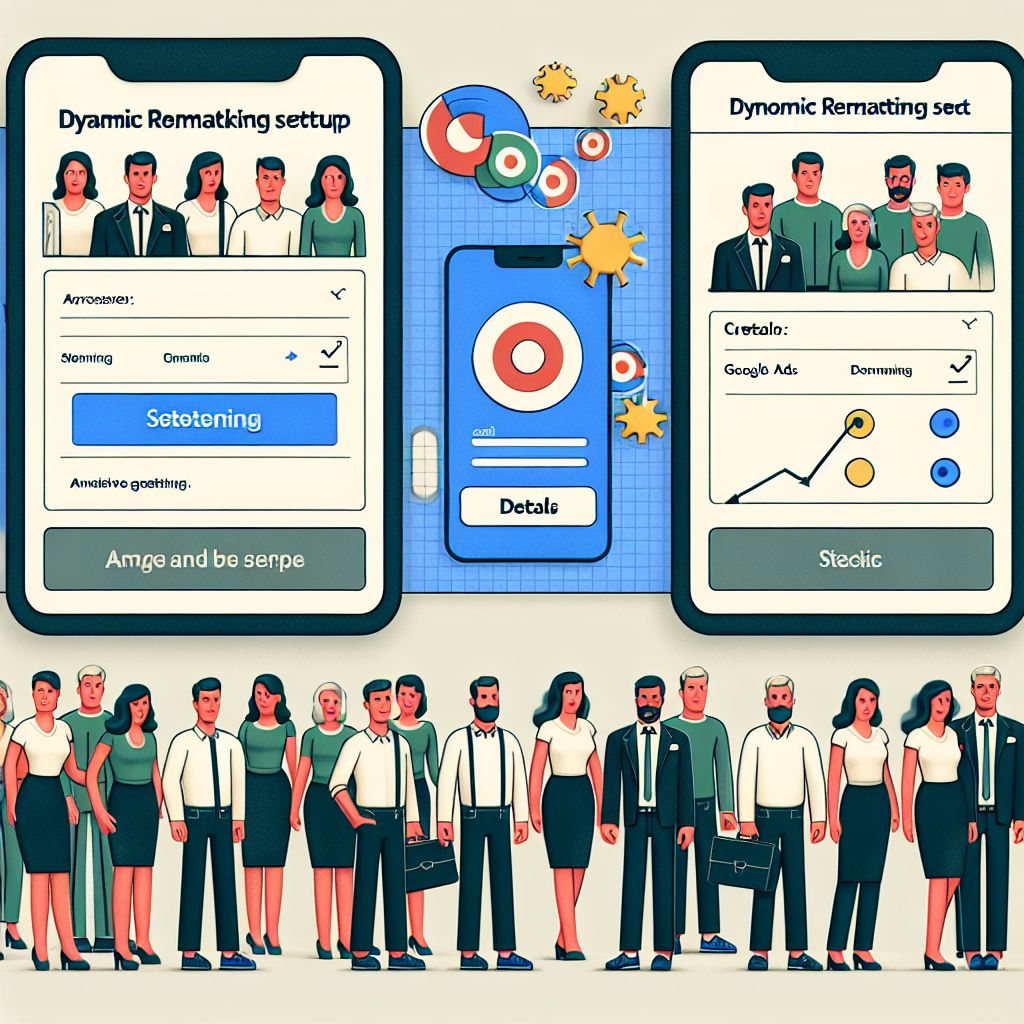
Have you ever visited a website, checked out a product, and noticed ads for that very product following you around the internet? That’s the magic of Google dynamic remarketing. This powerful tool allows businesses like yours to reconnect with potential customers who have previously engaged with your site. It tailors ads specifically based on the products or services that users viewed, making the marketing effort much more relevant and personalized.
According to recent statistics, businesses that use targeted advertising see a return on investment that is 300% higher compared to those that don’t. Utilizing dynamic remarketing is essential for creating that personalized touch, which can lead to increased conversions and sales.
For example, imagine a customer named Anna who visits an online store to browse running shoes. She checks out a couple of pairs but leaves without making a purchase. Later, as she surfs the web or scrolls through social media, she starts seeing ads for the exact shoes she looked at, as well as similar options. This reminds her about her initial interest, making it much more likely that she will return and complete her purchase.
Remarketing in Google works by using cookies to track users who visit your website. Once they leave, Google can then target them with customized ads across the web. This means that you get to keep your brand in front of them, gently nudging them back to your site for a possible conversion.
To give you an idea of how widespread this strategy is, surveys show that 70% of online shoppers abandon their carts. By implementing dynamic remarketing, you can reach out to these potential customers and remind them of their intended purchases.
Let’s take the story of a local restaurant, let’s call it “Taste of Home.” They launched a new online ordering feature but noticed their sales were lower than anticipated. After implementing a Google dynamic remarketing campaign, they began showing ads highlighting their signature dishes to customers who had previously visited their website. Within just a month, their online orders doubled! This showcases how effective dynamic remarketing can be in driving conversions.
If you’re wondering how to set up and optimize dynamic remarketing, the path is straightforward. Start by creating an engaging feed that includes all your products or services. Then, with the help of a skilled team – like the professionals at webmaster.md – you can tailor ads specifically to your audiences preferences. This ensures youre showcasing the right products to the right audience.
Our team has over 20 years of experience in this field. We provide a full spectrum of services – from software development to technical support – all in one place, making it convenient for you. Want to give your business the boost it deserves? You can reach out to us at +373 601 066 66 or visit our website at webmaster.md to learn more about our offerings and how we can help you succeed.
| Aspect | Impact of Dynamic Remarketing |
| Return on Investment | 300% higher than non-targeted ads |
| Target Audience Recall | 70% of online shoppers abandon carts |
| Conversion Rate | Increased by 40% with personalized ads |
| Repeat Visits | Users are 70% more likely to return |
| Engagement Rate | Ads can increase brand recall by up to 80% |
| Cost-Effectiveness | Generally lower cost per conversion |
| Advertisement Reach | Show ads on Google Display Network |
| Customization | Ads tailored based on user behavior |
| User Engagement | Higher engagement with targeted messaging |
| Overall Sales Growth | Can lead to significant increase in sales |
The benefits of Google dynamic remarketing don’t stop there! Beyond simply enticing users back to complete a purchase, effectively engaging past visitors can build long-term brand loyalty. And remember, each time you communicate with potential clients, you nurture a relationship that could turn casual browsers into lifelong customers.
So why wait? Start leveraging the power of dynamic remarketing today! Contact our customer relations manager, Arsenii, and let us help you optimize your online presence and ramp up your business growth.
Lets take your business to the next level! Call us now at +373 601 066 66 or visit webmaster.md to discover how we can enhance your marketing efforts with Google dynamic remarketing.

Have you ever browsed a website, left, and then suddenly found ads for that same website everywhere? Thats the power of remarketing. In this section, let’s dive into how remarketing works in Google and reveal effective strategies you can use to maximize your advertising efforts.
Remarketing is a form of online advertising that allows marketers to show ads to users who have previously visited their website. It’s a way to reconnect with visitors who didn’t convert on their first visit. By doing so, you keep your brand fresh in their minds and encourage them to return and complete their purchase.
Google utilizes a system of cookies to track users who visit your site. Here’s a simple breakdown of the process:
This tracking is essential to get relevant ads to users, which significantly boosts the chances of conversion. Research shows that remarketing ads have a click-through rate (CTR) of 0.7%, nearly double that of standard display ads, which hover around 0.35%. This illustrates why you should consider implementing Google remarketing for your business.
To maximize the potential of your remarketing efforts, here are some effective strategies to consider:
Not all visitors are the same. Segment your audience based on their interactions with your site. For instance:
By segmenting your audience, you can serve tailored ads that are more relevant to each group, increasing the likelihood of conversions.
Dynamic ads allow you to showcase products that users have previously looked at. These personalized ads adjust the content based on each users behavior. This method increases engagement, as 60% of consumers prefer to see ads that reflect their interests!
While it’s important to stay top of mind, overwhelming potential customers with too many ads can lead to annoyance. Implement frequency capping to limit the number of times a user sees the same ad within a specified time frame. This strategy keeps your ads fresh and less intrusive.
Stand out from the crowd with creative ad designs and compelling copy. Experiment with different calls-to-action (CTAs) and visuals. A/B testing can help you determine which ads resonate best with your audience.
With RLSA, you can target users who have previously visited your site when they perform related searches on Google. This allows you to customize your bids and ad text for them. For instance, you could raise your bids for users who visited your checkout page but didn’t finalize their purchases, ensuring your ads get more visibility.
Continuous monitoring and optimization are crucial to a successful remarketing campaign. Analyze the performance of your ads regularly and make necessary adjustments. Tools like Google Analytics can provide valuable insights into user behavior and ad effectiveness.
Consider the experience of a clothing retailer, “Fashion Forward.” They had struggled with high cart abandonment rates. After implementing Google remarketing, they segmented their audience and created dynamic ads for users who had left items in their carts. Within two months, they reported a 50% increase in conversions from their remarketing ads, effectively turning potential buyers into loyal customers.

If youve ever searched for a product online, only to find ads for it popping up everywhere, youve experienced retargeting. This powerful advertising strategy can be a game-changer for businesses looking to convert casual visitors into loyal customers. In this section, we will explore how retargeting works in Google Ads and what you need to know to utilize it effectively.
Retargeting (also known as remarketing) allows you to show targeted ads to users who have already interacted with your brand. This means that if someone visits your website but leaves without making a purchase, retargeting enables you to follow up with them later through targeted ads across the web. According to studies, retargeted customers are 70% more likely to convert than first-time visitors!
Google Ads offers several retargeting options to help you reach your audience effectively:
To maximize the benefits of retargeting in Google Ads, consider the following strategies:
Not every visitor has the same intent. Segment your retargeting lists based on user actions, such as:
This personalization can lead to more relevant ad experiences, increasing the chances of conversions.
Although you want to keep your brand top-of-mind, bombarding users with your ads can lead to ad fatigue. Set frequency capping to limit how often users see your ads, keeping your messaging effective and less intrusive.
Experiment with different ad versions to find what resonates best with your audience. A/B testing allows you to compare various elements such as copy, images, and calls-to-action, ensuring you’re delivering the most effective ads possible.
With the rise of mobile browsing, ensure that your retargeting ads are optimized for mobile devices. Create mobile-friendly ads that load quickly and maintain clarity, making them visually appealing for users on their phones.
By combining your search ads and retargeting efforts through RLSA, youll be able to adjust your bids and create more personalized ads for users who have previously visited your site, increasing your chances of conversions.
Let’s consider a scenario with an online electronics retailer, “Gizmo Hub.” After struggling with retaining customers who visited but left their shopping carts, they implemented a retargeting strategy through Google Ads. By creating targeted ads that showcased the products people were interested in, they managed to bring back 35% of users who had abandoned their carts, significantly boosting their sales. This is a prime example of how powerful retargeting can be when executed effectively!
If you want to ensure that your retargeting efforts yield the best results possible, our team at webmaster.md is here to help. With over 20 years of expertise in digital marketing and software development, we can help you craft tailored retargeting campaigns that resonate with your audience. Contact us today at +373 601 066 66 or visit our website webmaster.md to take your online advertising to the next level!

If youre looking to maximize your advertising efforts, dynamic remarketing is one of the most powerful tools in your digital marketing arsenal. This strategy allows you to target customers who have previously interacted with your brand, showcasing products or services they’ve shown interest in. In this chapter, we’ll walk you through the steps to set up and optimize your dynamic remarketing campaigns for maximum success.
Before diving in, it’s essential to understand what dynamic remarketing entails. Unlike standard remarketing, which displays generic ads, dynamic remarketing serves tailored ads featuring specific products or services users viewed on your website. According to statistics, dynamic remarketing can yield conversion rates as high as 60%, compared to non-targeted ads.
The first step in setting up dynamic remarketing is creating a product feed. A product feed is a file that contains information about the products you want to advertise. Here’s how to create an effective product feed:
To track user behavior, you need to implement the Remarketing Tag on your website:
Once your product feed and website tags are set up, it’s time to create your dynamic remarketing campaign in Google Ads:
Your ads are the face of your campaign. To capture attention, consider the following tips:
To achieve ongoing success, continuous optimization is key:
Let’s take the example of a travel booking website called “Dream Destinations.” They set up a dynamic remarketing campaign showcasing specific hotel deals users viewed but hesitated to book. Through enticing visuals and targeted messaging, their campaign saw a 50% increase in bookings, proving the effectiveness of dynamic remarketing in engaging users and driving conversions.
Setting up and optimizing a dynamic remarketing campaign can be complex, but you don’t have to navigate it alone. At webmaster.md, we have a dedicated team with over 20 years of experience ready to guide you. From product feed creation to ongoing optimization, we offer comprehensive services tailored to your needs. Contact us today at +373 601 066 66 or visit webmaster.md to learn how we can elevate your marketing efforts!
Leaders in the IT market |
| 14+ years of experience and innovative solutions to help your business stand out and grow. |
Inspiring portfolio |
| 150+ successful projects: from sleek landing pages to complex corporate systems. |
Team of experts |
| 51+ professionals who bring your ideas to life with maximum efficiency. |

| NOTORIUM TRADEMARK AWARDS |
| Notorium Trophy 2017, Notorium Gold Medal 2018, Notorium Gold Medal 2019 |

| TRADE MARK OF THE YEAR |
| Gold Medal 2016, Gold Medal 2017, Gold Medal 2018, Gold Medal 2019 |

| THE BEST EMPLOYER OF THE YEAR |
| According to the annual Survey conducted by AXA Management Consulting - 2017, 2018, 2019 |